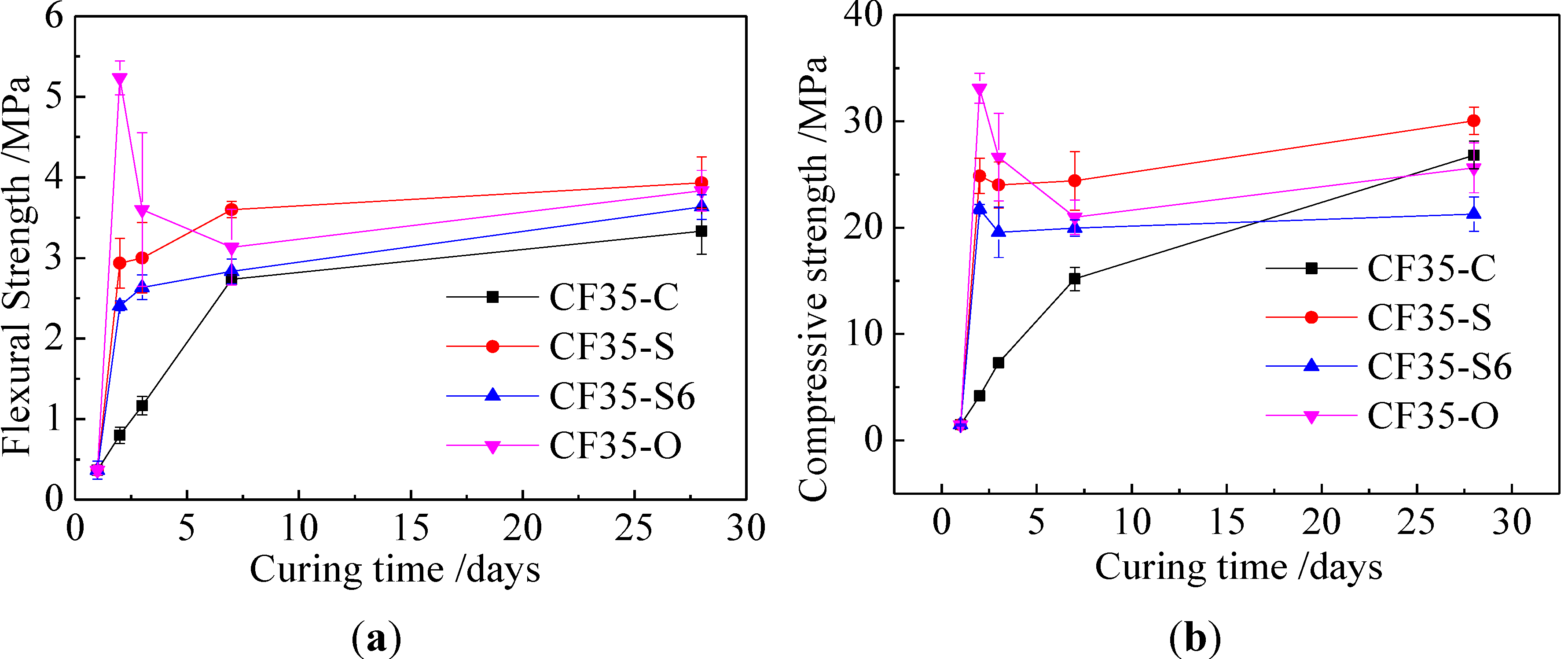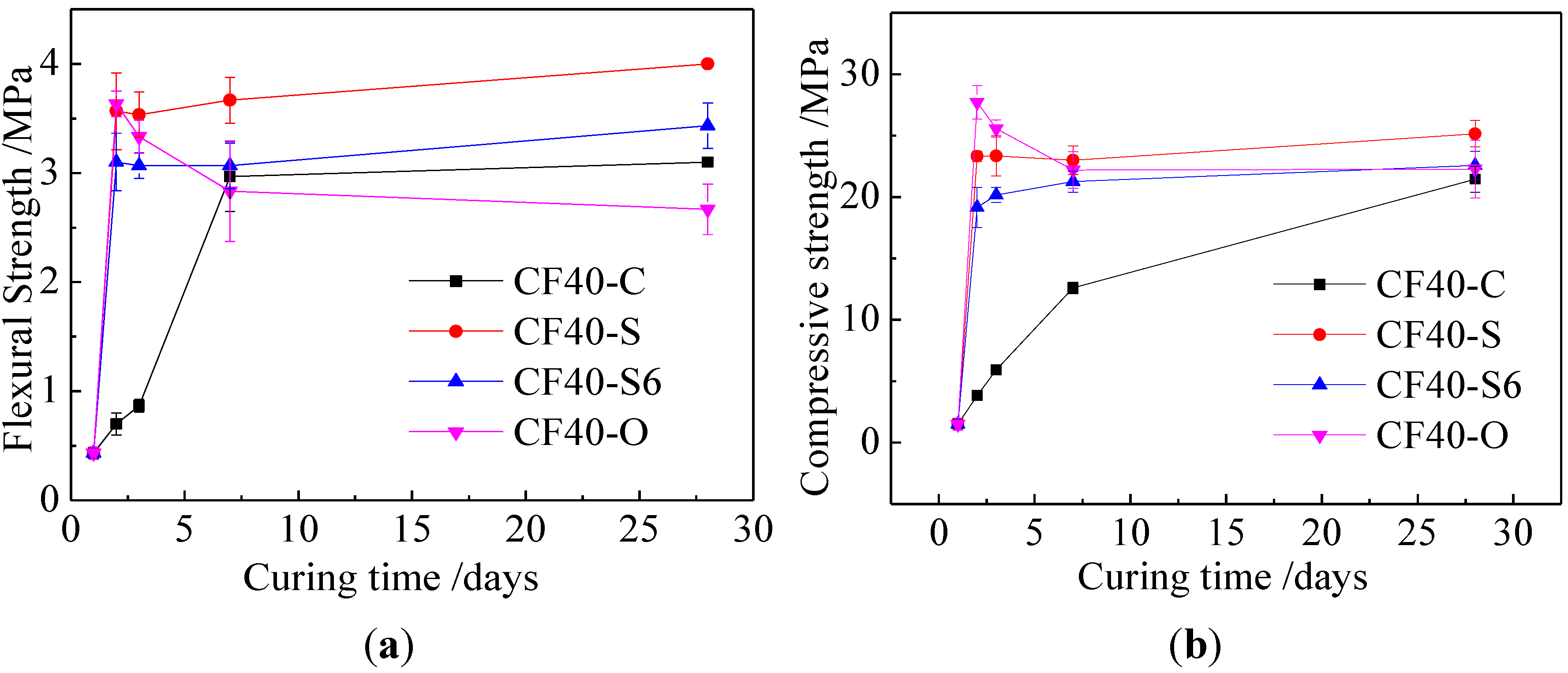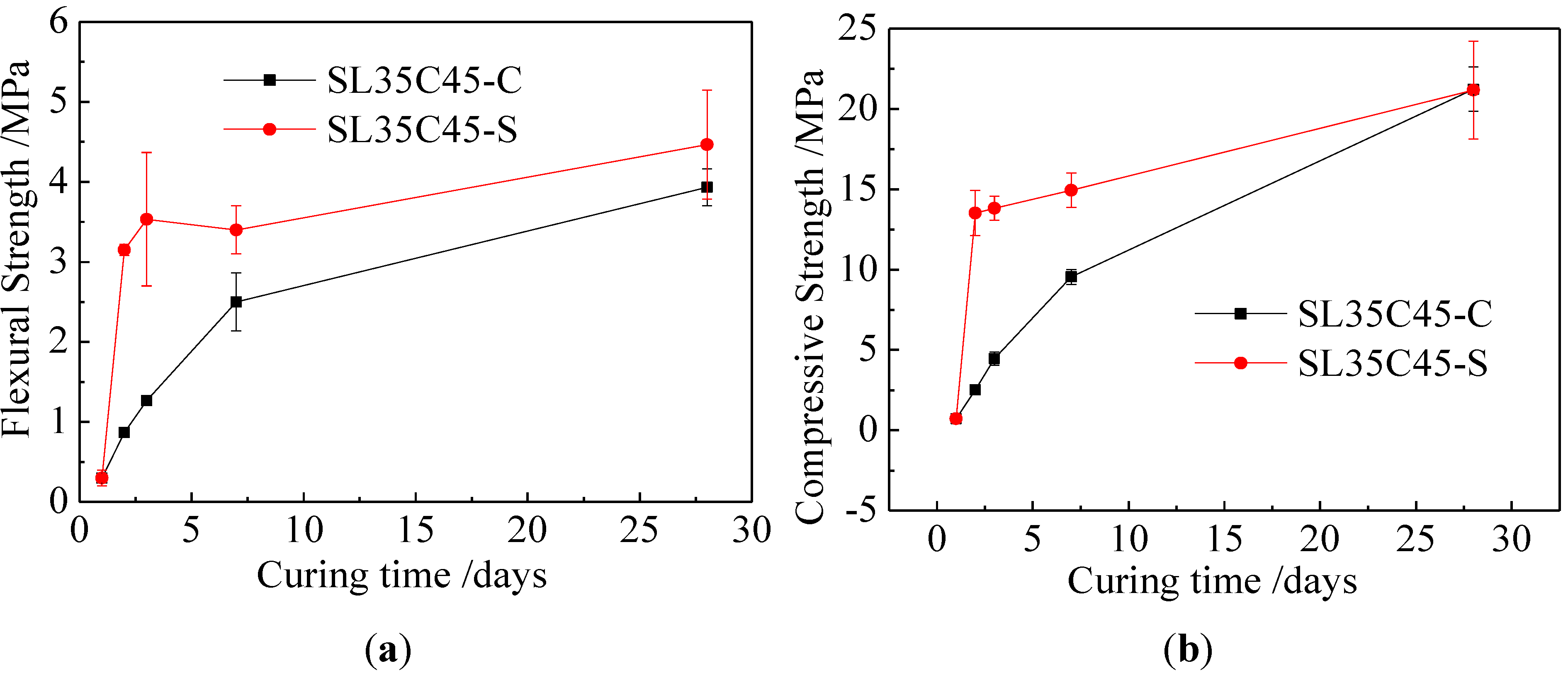Influence of Curing on the Strength Development of Calcium-Containing Geopolymer Mortar
Abstract
:1. Introduction
2. Experimental
2.1. Materials
| Oxide | Percentage (wt %) | ||
|---|---|---|---|
| Class C fly ash | Class F fly ash | slag | |
| SiO2 | 48.2 | 62.29 | 31.23 |
| Al2O3 | 18.4 | 15.94 | 17.16 |
| Fe2O3 | 3.7 | 6.24 | 1.88 |
| CaO | 19.6 | 7.92 | 38.66 |
| MgO | 1.1 | 1.57 | 8.6 |
| SO3 | 1.7 | – | – |
| f-CaO | 5.2 | – | – |
2.2. Design of Mix Proportion
| Code | Mole ratio | Mass ratio | NaOH/Ash | ||||
|---|---|---|---|---|---|---|---|
| SiO2/Al2O3 | Na2O/Al2O3 | Na2O/SiO2 | CaO/SiO2 | H2O/Na2O | Ash/Sand | ||
| CF35 | 5.38 | 0.71 | 0.13 | 0.46 | 15.14 | 0.5 | 0.058 |
| CF40 | 5.38 | 0.71 | 0.13 | 0.46 | 17.31 | 0.5 | 0.058 |
| FFC35 | 7.72 | 0.82 | 0.11 | 0.17 | 15.14 | 0.5 | 0.058 |
| FFS35 | 7.31 | 0.82 | 0.11 | 0.17 | 15.14 | 0.5 | 0.058 |
2.3. Specimen Preparation
3. Results and Discussion
3.1. Strength Development of Class C Fly Ash Geopolymer Mortar


3.2. Strength Development of Class F Fly Ash Geopolymer Mortar


4. Conclusions
- (1)
- For the Class C fly ash geopolymers, the early-age (<7 days) strength of oven curing was the highest, followed by that from steam curing conditions at 60 °C for 24 h. Both high temperature curing conditions showed higher strength than standard curing conditions at early age. At later ages, however, standard curing showed comparable or higher mechanical strength.
- (2)
- Addition of slag addition and calcium hydroxide was indicated to improve the strength of Class F fly ash geopolymer at early ages under the standard curing conditions.
Acknowledgments
Conflicts of Interest
References
- Duxson, P.; Fernández-Jiménez, A.; Provis, J.L.; Lukey, G.C.; Palomo, A.; van Deventer, J.S.J. Geopolymer technology: The current state of the art. J. Mater. Sci. 2007, 42, 2917–2933. [Google Scholar]
- Provis, J.L.; Lukey, G.C.; van Deventer, J.S.J. Do geopolymers actually contain nanocrystalline zeolites? A reexamination of existing results. Chem. Mater. 2005, 17, 3075–3085. [Google Scholar] [CrossRef]
- Takeda, H.; Hashimoto, S.; Yokoyama, H.; Honda, S.; Iwamoto, Y. Characterization of zeolite in zeolite-geopolymer hybrid bulk materials derived from kaolinitic clays. Materials 2013, 6, 1767–1778. [Google Scholar] [CrossRef]
- Ferone, C.; Colangelo, F.; Roviello, G.; Asprone, D.; Menna, C.; Balsamo, A.; Prota, A.; Cioffi, A.; Manfredi, G. Application-oriented chemical optimization of a metakaolin based geopolymer. Materials 2013, 6, 1920–1939. [Google Scholar] [CrossRef] [Green Version]
- Bernal, S.A.; Provis, J.L.; Rose, V.; Gutierrez, R.M. Evolution of binder structure in sodium silicate-activated slag-metakaolin blends. Cem. Concr. Compos. 2011, 33, 46–54. [Google Scholar] [CrossRef]
- Wang, J.; Wu, X.-L.; Wang, J.-X.; Liu, C.-Z.; Lai, Y.-M.; Hong, Z.-K.; Zheng, J.-P. Hydrothermal synthesis and characterization of alkali-activated slag-fly ash-metakaolin cementitious materials. Microporous Mesoporous Mater. 2012, 155, 186–191. [Google Scholar]
- Ferna, A.; Palomo, A. Characterisation of fly ashes. Potential reactivity as alkaline cements. Fuel 2003, 82, 2259–2265. [Google Scholar] [CrossRef]
- Li, C.; Sun, H.; Li, L. A review: The comparison between alkali-activated slag (Si + Ca) and metakaolin (Si + Al) cements. Cem. Concr. Res. 2010, 40, 1341–1349. [Google Scholar] [CrossRef]
- Escalante-Garcia, J.I.; Espinoza-Perez, L.J.; Gorokhovsky, A.; Gomez-Zamorano, L.Y. Coarse blast furnace slag as a cementitious material, comparative study as a partial replacement of Portland cement and as an alkali activated cement. Constr. Build. Mater. 2009, 23, 2511–2517. [Google Scholar] [CrossRef]
- Haha, M.B.; Saout, G.L.; Winnefeld, F.; Lothenbach, B. Influence of activator type on hydration kinetics, hydrate assemblage and microstructural development of alkali activated blast-furnace slags. Cem. Concr. Res. 2011, 41, 301–310. [Google Scholar]
- Xin, T.; Hu, H. Test and study on electrical property of conductive concrete. Procedia Earth Planet Sci. 2012, 5, 83–87. [Google Scholar] [CrossRef]
- Krizana, D.; Zivanovic, B. Effects of dosage and modulus of water glass on early hydration of alkali-slag cements. Cem. Concr. Res. 2002, 32, 1181–1188. [Google Scholar] [CrossRef]
- Hu, M.Y.; Zhu, X.M; Long, F.M. Alkali-activated fly ash-based geopolymers with zeolite or bentonite as additives. Cem. Concr. Compos. 2009, 31, 762–768. [Google Scholar] [CrossRef]
- Palomo, A.; Grutzeck, M.W.; Blanco, M.T. Alkali-activated fly ashes: A cement for the future. Cem. Concr. Res. 1999, 29, 1323–1329. [Google Scholar] [CrossRef]
- Zuda, L.; Drchalov, R.J.; Bayer, P.; Keršner, Z.K.; Erny, R.C. Alkali-activated aluminosilicate composite with heat-resistant lightweight aggregates exposed to high temperatures: mechanical and water transport properties. Cem. Concr. Compos. 2010, 32, 157–163. [Google Scholar]
- Yang, X.; Ni, W.; Zhang, X.; Wang, Y. Effect of alkali-activation on aluminosilicate-based cementitious materials. J. Univ. Sci. Technol. B 2008, 15, 796–801. [Google Scholar] [CrossRef]
- Fernández, A.; Palomo, A. Composition and microstructure of alkali activated fly ash binder: Effect of the activator. Cem. Concr. Res. 2005, 35, 1984–1992. [Google Scholar] [CrossRef]
- Bakharev, T. Geopolymeric materials prepared using Class F fly ash and elevated temperature curing. Cem. Concr. Res. 2005, 35, 1224–1232. [Google Scholar] [CrossRef]
- Temuujin, J.; van Riessen, A.; MacKenzie, K.J.D. Preparation and characterisation of fly ash based geopolymer mortars. Const. Build. Mater. 2010, 24, 1906–1910. [Google Scholar] [CrossRef]
- Antiohos, S.K.; Tsimas, S. A novel way to upgrade the coarse part of a high calcium fly ash for reuse into cement systems. Waste Manag. 2007, 27, 675–683. [Google Scholar] [CrossRef] [PubMed]
- Li, X.Y.; Ma, X.W.; Zhang, S.J.; Zheng, E.Z. Mechanical properties and microstructure of Class C fly ash-based geopolymer paste and mortar. Materials 2013, 6, 1485–1495. [Google Scholar]
- Guo, X.L.; Shi, H.S.; Dick, W.A. Compressive strength and microstructural characteristics of Class C fly ash geopolymer. Cem. Concr. Compos. 2010, 32, 142–147. [Google Scholar] [CrossRef]
- Duxson, P.; Fernandez-Jimenez, A.; Provis, J.L.; Lukey, G.C.; Palomo, A.; van Deventer, J.S.J. Geopolymer technology: The current state of the art. J. Mater. Sci. 2007, 42, 2917–2933. [Google Scholar] [CrossRef]
- Granizo, M.L.; Alonso, S.; Blanco-Varela, M.T.; Palomo, A. Alkaline activation of metakaolin: Effect of calcium hydroxide in the products of reaction. J. Am. Ceram. Soc. 2002, 85, 225–231. [Google Scholar] [CrossRef]
- Criado, M.; Palomo, A.; Fernandez-Jimenez, A. Alkali activation of fly ashes. Part 1: Effect of curing conditions on the carbonation of the reaction products. Fuel 2005, 84, 2048–2054. [Google Scholar] [CrossRef]
- Kovalchuk, G.; Fernandez-Jimenez, A.; Palomo, A. Alkali-activated fly ash: Effect of thermal curing conditions on mechanical and microstructural development—Part II. Fuel 2007, 86, 315–322. [Google Scholar] [CrossRef]
- Bakharev, T. Thermal behaviour of geopolymers prepared using Class F fly ash and elevated temperature curing. Cem. Concr. Res. 2006, 36, 1134–1147. [Google Scholar] [CrossRef]
- Kong, D.L.Y; Sanjayan, J.G. Damage behavior of geopolymer composites exposed to elevated temperatures. Cem. Concr. Compos. 2008, 30, 986–991. [Google Scholar] [CrossRef]
- Pangdaeng, S.; Phoo-ngernkham, T.; Sata, V.; Chindaprasirt, P. Influence of curing conditions on properties of high calcium fly ash geopolymer containing Portland cement as additive. Mater. Des. 2014, 53, 269–274. [Google Scholar]
© 2013 by the authors; licensee MDPI, Basel, Switzerland. This article is an open access article distributed under the terms and conditions of the Creative Commons Attribution license (http://creativecommons.org/licenses/by/3.0/).
Share and Cite
Li, X.; Wang, Z.; Jiao, Z. Influence of Curing on the Strength Development of Calcium-Containing Geopolymer Mortar. Materials 2013, 6, 5069-5076. https://doi.org/10.3390/ma6115069
Li X, Wang Z, Jiao Z. Influence of Curing on the Strength Development of Calcium-Containing Geopolymer Mortar. Materials. 2013; 6(11):5069-5076. https://doi.org/10.3390/ma6115069
Chicago/Turabian StyleLi, Xueying, Zheng Wang, and Zhenzhen Jiao. 2013. "Influence of Curing on the Strength Development of Calcium-Containing Geopolymer Mortar" Materials 6, no. 11: 5069-5076. https://doi.org/10.3390/ma6115069




